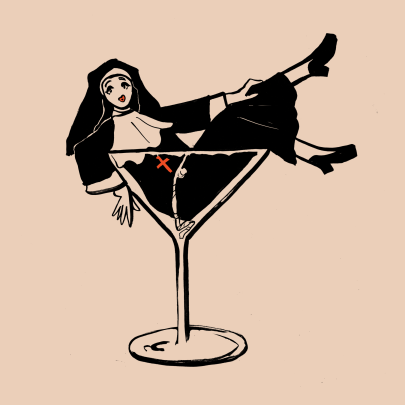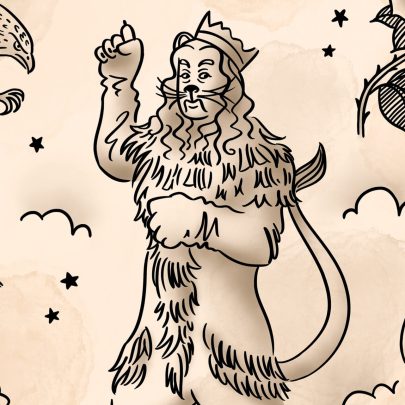Feb 27, 2015 Theatre
Theatre critic James Wenley looks back on a festival with plenty to enjoy — and some major disappointments.
Little Red Riding Hood is a total bad-ass
Appearing as Little Red Riding Hood, Wellingtonian Deborah Eve Rea bought her red-o-lution tour to The Basement to expose the truth behind Little Red’s story. The reimagining of fairy tales is voguish and a little tired, but Deborah finds some new things to say about it all, and makes us consider exactly what messages we are sending when we feed this story to young kids. By treating the trauma of the wolf seriously, her format allows for surprising depth (hello ACC’s treatment of sexual abuse cases) alongside her fairytale revisionism.
Eve Rea uses music to punctuate her statements, but it disrupts the show as much as it adds, she’s engaging enough without it. She rightfully skewers the Amanda Seyfried Red Riding Hood film, but I would have also been interested in her thoughts on the neutering of the psychosexual elements in the recent Into the Woods film. This was one of several shows this Fringe, including Live Orgy and Torum Heng’s Basement Box office hit Keep out of my Box (and other useful advice), that used fresh eyes to consider contemporary gender discourse and comedy to promote serious and urgent messages. Viva le Red-o-lution.
Now he’s reached rock bottom, David Cunliffe may still rise again
Joseph Harper had a late night slot and only three performances, so I hope this isn’t the last we see of his show I am a Cat (the first show where Harper has charged proper ticket prices, rather than his usual koha). Harper is something of a deconstructionist performer: he’s so casual, haphazard even, that it looks like he’s making it all up as he goes along. This is what makes him such a charming story-weaver.
“Comedy is easy”, he says, when one of his gags gets a good response. But Harper is anything but lazy, and his shows demand intelligent, philosophical audiences. In a sort of prologue he tells us he’s been thinking about wheels, specifically the wheel of fortune. The medieval diagram of the wheel of fortune is always included in Shakespeare PowerPoint slides at uni, and basically posits that life moves in ups and downs. You might have reached the top, but the wheel is already starting to turn downwards.
Next, we meet the feline of the title, a street cat with a love of fish that turns out to be a harbinger of doom for opposition leaders. He was outside Cunliffe’s house during on election night last year, and previously belonged to Bill English circa 2002. I am a Cat is an incredibly niche show – for political-junkie cat lovers who have read a bit of Chaucer – and has some deep reflections on fate and fortune. I loved it. English rode the wheel back up to power. Cunliffe might consider burying himself in philosophical tracts for comfort.
Don’t try to shoe-horn charities into your musical experiments
I wouldn’t normally spoil endings, but to get across the dissonance I felt at the end of the show, I have no other choice. So if you were planning to get to Eat the Young Fresh (and really, you might wish to rethink that decision), you can skip this one till after the show. At the end of the musical, a baby, with a bloody knife sticking out of its little belly, is placed on the dinner table by her mother, who has post-natal depression. But what I’m most floored about is the small box next to us, asking us to donate to charity. 260,000 kids are in poverty, the box tells me. What we have just witnessed has nothing to do with child poverty, and all to do with a poverty of dramaturgy.
Sure, writer/composer Patrick Kelly was inspired by Jonathan Swift’s 1729 satirical article about selling the infants of the poor to be eaten by the wealthy. The show begins with a failed advertising pitch for a marketing campaign to “Eat Fresh”, which alternated between pictures of vegetables and babies.. From there, the show becomes Shortland Street The Musical, with relationship breakdowns, miscarriages, one-night stands, partner-swapping, guilty secrets, and unearned emotional ballads.
The cast, Romy Hooper, Alexandra McKellar and Paul Fagamalo, perform with utter commitment, their talents far superior to the show they are in. What’s frustrating is that there are some really rather good hummable songs here, mostly given to McKellar. One where she describes her day in 20 minutes blocks of time has a Jason Robert Brown (The Last Five Years) feel, and sung anguish over waiting for a pregnancy test result is memorable.
The marketing and programme suggested we might get a contemporary black comedy version of Swift’s modest proposal. Eat the Young Fresh is anything but. To claim that this show has a message about child poverty in New Zealand is, frankly, offensive in the extreme. Go back to development, and unless the messages relates, keep the charities out of it.
Grace Taylor’s poetry makes for an awesome dance show
Rising choreographers Jahra Rager and Grace Woollett have responded to Grace Taylor’s 2013 debut poetry collection, Afakasi Speaks, by creating Mother/Jaw, a politically orientated and powerful dance meditation on belonging. The dancers bring with them plaster moulds of skeletal jaws, ancestors now silenced. The dancers confront the challenges of articulating contemporary ethnicity, informed by the knowledge, guilt and shame of colonial history. Kevin Rudd’s “I’m sorry”, played in a loop, sends shockwaves through the performers. In a work that is about both the failure and power of language, Taylor’s text and the dancer’s movements commune urgently with each other. Mother/Jaw stuns. Two more nights to go.
Dinosaurs and cave-people did co-exist, and were even friends
Okay, so Prehistoria may not be entirely archeologically accurate, but by setting their dinosaur-cavewomen-caveman love triangle rom-com “ages ago” it adds instant comic potential. Performers Eli Mathewson (the bashful Dino) and Laura Daniel (the resourceful cave-gal) mix The Flintstones with some absurd clowning. They eat leaves, hunt cute animal soft-toys, and take big sniffs of audience members, attracted by our pungent smells.
Just as the pair have started to get to know each other, Dino is friend-zoned by an alpha cave-man played by Oscar Wilson (wearing a teeny-tiny loin cloth), who uses his dance background to attract Daniel with some very smooth moves. You know this story, and with meteorites falling throughout the show, know how it might end, but this unpretentious comedy delivers the biggest laughs of the Fringe. It also has a very cute theme song. Catch Prehistoria after Mother/Jaw tonight or Saturday.
Listen to the wisdom of grandmothers
We first meet Porpor (from the Chinese for maternal grandmother) on a plane from Hong Kong, bound for New Zealand. Actress Hweiling Ow is crouched over, making her small frame smaller still. We see an old lady. But as Porpor says, what we “don’t see” is the time she ran away from a Japanese soldier, or when she danced a Tango. Which she then shows us, creaky joints and all. It’s rather charming.
Under the Same Moon is playwright Renee Liang’s No 2. Like Toa Fraser’s film, her one-woman show focuses on family and culture in New Zealand, but unlike Fraser’s, the grandmother is estranged from her family. She has invited herself to see her three granddaughters again, one of whom is getting married. It’s a gentle comedy, pulled off with skill by Ow as she inhabits the characters of Liang’s tale. There is room still to grow the themes, and spend more time getting to know the rest of the family.
Porpor, inspired by Liang’s “feisty” grandmothers, is a delightful creation. Though she says she’s “good at talking nonsense more and more” these days, she has some very wise things to say. Her family have sent her “money for food” but “no words”. Those are most important. She also has a wonderful habit of talking to her old friend, the moon. Under the Same Moon (along with Liang’s play for children, The Two Farting Sisters) continues through next week. Porpor is worth meeting.
Build it and they will come… but only if you tell people about it
Auckland Fringe’s fourth festival has been beset with problems. The Fringe website, and the announcement of the full programme, arrived late and did not prove user-friendly in helping viewers buy the all-important tickets. The Fringe print programme finally appeared after the first shows had already begun.
It was notable that shows also aligned with the Pride Festival did well, and The Basement hummed along with its core audience in attendance, but spaces like Q Vault’s proved a noose around artists’ necks. There were some notable successes — Ponsonby tribute I Wanna Be Na Nah Na Nah Nah sold out early, and Victor Rodger’s Girl on a Corner is coming back to The Basement in March — but due to issues getting the word out, this Auckland Fringe was even more Fringe than usual in terms of wider awareness. It’s not a good look either for international artists looking to make Fringe one of the stops in their tours. Auckland has artists in abundance to make for a truly exciting Fringe. They deserve better than this sloppy affair.





